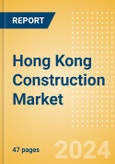The Construction in Hong Kong - Key Trends and Opportunities to 2029 (H1 2025) report provides detailed market analysis, information, and insights into Hong Kong’s construction industry, including:
- Hong Kong’s construction industry's growth prospects by market, project type and construction activity
- Critical insight into the impact of industry trends and issues, as well as an analysis of key risks and opportunities in Hong Kong’s construction industry
- Analysis of the mega-project pipeline, focusing on development stages and participants, in addition to listings of major projects in the pipeline.
Over the remainder of the forecast period, the construction industry’s output is expected to register an annual average growth rate of 2.6% from 2026-29, supported by investments in transport, electricity, housing, and industrial projects. The government plans to develop three major road schemes and three strategic railway projects to drive and support the city's development by 2030. It involves six projects that will result in a highly interconnected and accessible road network and rail system, as per the “Railways and Major Roads beyond 2030”. In another boost to the infrastructure sector's output, in December 2024, the Legislative Council by the Transport and Logistics Bureau reported that work is progressing on the Tung Chung Line (TCL) Extension, Tuen Mun South (TMS) Extension, Oyster Bay (OYB) Station, Northern Link (NOL) Phase 1 Kwu Tung (KTU) Station, and Hung Shui Kiu (HSK) Station, with completion of these projects scheduled from 2027 onwards. Moreover, construction works of the NOL Main Line is planned to commence in 2025 and be completed in 2034. Furthermore, in November 2024, the Finance Committee of the Legislative Council approved HKD21.5 billion ($2.8 billion) for the widening of Hiram’s Highway between Marina Bay and Sai Kung Town. The project includes expanding two sections of Sai Kung Highway (3.5km total) from a two-lane to a dual two-lane carriageway, as well as upgrades to Pak Sha Wan and surrounding roads. Additionally, it plans for a pedestrian subway and improvements to drainage, waterworks, and public transportation. The construction is expected to start in 2025 and be completed by 2027.
Scope
This report provides a comprehensive analysis of the construction industry in Hong Kong. It provides:
- Historical (2020-2024) and forecast (2025-2029) valuations of the construction industry in Hong Kong, featuring details of key growth drivers.
- Segmentation by sector (commercial, industrial, infrastructure, energy and utilities, institutional and residential) and by sub-sector
- Analysis of the mega-project pipeline, including breakdowns by development stage across all sectors, and projected spending on projects in the existing pipeline.
- Listings of major projects, in addition to details of leading contractors and consultants
Reasons to Buy
- Identify and evaluate market opportunities using our standardized valuation and forecasting methodologies
- Assess market growth potential at a micro-level with over 600 time-series data forecasts
- Understand the latest industry and market trends
- Formulate and validate business strategies using the analyst's critical and actionable insight
- Assess business risks, including cost, regulatory and competitive pressures
- Evaluate competitive risk and success factors
Table of Contents
1 Executive Summary2 Construction Industry: At-a-Glance6 Construction Market Data
3 Context
4 Construction Outlook
5 Key Industry Participants
7 Appendix
List of Tables
List of Figures








